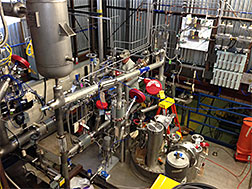- Number 406 |
- February 3, 2014
Prototype cryostat for neutrino experiment exceeds purity goals

This cryostat system has exceeded the
stringent liquid-argon purity requirements
for the Long-Baseline Neutrino Experiment.
Scientists and engineers working on the design of the particle detector for the proposed Long-Baseline Neutrino Experiment celebrated a major success in January. They operated for the first time a 35-ton prototype cryostat filled with liquid argon and met the stringent, less-than-200-parts-per-trillion purity requirement on oxygen contamination in the liquid.
The purity of liquid argon is crucial for the proposed LBNE neutrino detector. Oxygen and other electronegative impurities in the liquid can absorb ionization electrons created by neutrino interactions and prevent them from reaching the signal wires of the detector.
The test results were the outcome of the first phase of operating the LBNE prototype cryostat at DOE’s Fermi National Accelerator Laboratory. On Dec. 20, during a marathon 36-hour session, engineers cooled the cryostat — slowly and smoothly — to minus 262 degrees Fahrenheit and started to fill it with liquid argon from Fermilab’s Liquid-Argon Purity Demonstrator. The membrane cryostat, based on industrial-type design and components, holds about 6,500 gallons of liquid argon. In January, the LBNE team announced that the systems for purifying, recirculating and recondensing the argon worked properly and consistently achieved purity levels of about 100 ppt, significantly better than the minimum requirement of 200 ppt.
More than 450 scientists from 80 institutions collaborate on the design and planning of the proposed LBNE experiment, which would look for the violation of the matter-antimatter symmetry in neutrino interactions.[Kurt Riesselmann, 630.840.3351,
media@fnal.gov]
